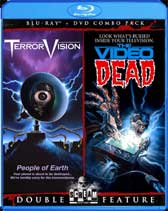 TERRORVISION/THE
VIDEO DEAD Blu-ray/DVD combo (1986/1987)
TERRORVISION/THE
VIDEO DEAD Blu-ray/DVD combo (1986/1987)Directors: Ted Nicolau/Robert Scott
Scream Factory/Shout!Factory
 TERRORVISION/THE
VIDEO DEAD Blu-ray/DVD combo (1986/1987)
TERRORVISION/THE
VIDEO DEAD Blu-ray/DVD combo (1986/1987)Scream Factory pairs up two 1980s “television terror” – that’s terror from out of the television, not genre TV movies – flicks for a Blu-ray/DVD combo double bill: Empire Pictures’ TERRORVISION and the surprisingly slick budget basement cult favorite THE VIDEO DEAD.
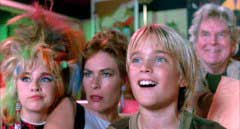
In TERRORVISION, the planet Pluton’s mutant disposal supervisor Pluthar (William Paulson, who had previously played an alien in Empire Pictures’ ZONE TROOPERS) converts slimy, toothsome beasts into energy and beams them to the far corners of the universe; however, one such creature accidentally gets beamed into the satellite dish of the well-to-do Putterman family: swinger parents Stanley (Gerrit Graham, PHANTOM OF THE PARADISE) and Raquel (Mary Woronov, SILENT NIGHT BLOODY NIGHT), daughter Suzy (Diane Franklin, AMITYVILLE II: THE POSSESSION), tyke Sherman (Chad Allen, TV’s DR. QUINN, MEDICINE WOMAN), and Gramps (Bert Remsen, SUNDOWN: THE VAMPIRE IN RETREAT). Pluthar sends a broadcast warning to the Earthlings to destroy their satellite dishes and televisions, but the beast has already figured out how to beam itself out of the television to go on a feeding frenzy with not only the Puttermans, but also visiting swingers Spiros (THE FLYING NUN’s Alejandro Rey) and Candy (Randi Brooks, TIGHTROPE), Suzy’s metalhead boyfriend OD (Jonathan Gries, JOYSTICKS), dish repairman Norton (Sonny Carl Davis, BAD CHANNELS), and horror hostess Medusa (Jennifer Richards) as potential menu items.
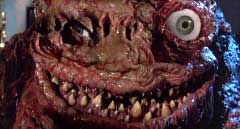 TERRORVISION
was the feature debut of Ted Nicolau, who had worked with Empire Pictures’
head Charles Band as an editor starting with his “Charles Band Productions”
films TOURIST TRAP, THE DAY TIME ENDED and THE ALCHEMIST (he would continue
to work occasionally as an editor during Band’s Full Moon Entertainment
days even as he mounted the SUBSPECIES quartet of films as writer and director).
Once one gets accustomed to the campy performances – more so Graham’s
mugging than Woronov’s strutting (which seem to have been later appropriated
by Peggy Bundy on Fox’s MARRIED WITH CHILDREN) or Franklin’s valley
girl-isms – TERRORVISION seems like family-oriented entertainment and
very self-assured. The tone shifts wildly, however, with the details of the
parents’ swingers lifestyle (and their pad’s interior decoration,
some of which had to be blurred out on the TV version) – more so when
Rey’s Greek voices his interests to Woronov – and the gooey monster
kills (the creature is equipped with a lobster claw and a vacuuming tongue),
before veering against towards the wholesome as Sherman, OD, and Suzy take a
liking to the homicidal beast’s puppy-like demeanor. In the accompanying
documentary (see below) Nicolau interprets the impressive production design
of Giovanni Natalucci – who built Danilo Donati’s CALIGULA sets
before mocking up some impressive and expansive settings on the cheap for a
number of Empire’s Italian entries including DOLLS – and the photography
of Romano Albani – who shot Dario Argento’s INFERNO and PHENOMENA
as well as TROLL for Empire – as being an “operatic Italian version
of American culture”. Graham and Woronov are entertainingly campy as ever,
as are Gries’ spastic air guitar mannerisms, and lead Franklin pulls some
amusing teenage girl guffaws, but nine year old Allen gives an impressive performance
for a child actor (and the exaggerated behavior of other characters could be
justified from the perspective of his straightman character). It’s disturbing
to hear THE FLYING NUN’s Rey – despite playing a playboy on that
show – talking about sexual lubricants and being “into Greek”
but the actor plays the part with gusto. Ian Patrick Williams (who also appeared
in Stuart Gordon’s Empire pics DOLLS, RE-ANIMATOR and ROBOT JOX) briefly
appears as a policeman, and Columbia-licensed (now Sony) clips from EARTH VS.
THE FLYING SAUCERS and THE GIANT CLAW, as well as ROBOT MONSTER (with some re-voicing
by Nicolau himself) appear on the television sets (as well as some innocuous
orgy footage that might be from Band’s AUDITIONS).
TERRORVISION
was the feature debut of Ted Nicolau, who had worked with Empire Pictures’
head Charles Band as an editor starting with his “Charles Band Productions”
films TOURIST TRAP, THE DAY TIME ENDED and THE ALCHEMIST (he would continue
to work occasionally as an editor during Band’s Full Moon Entertainment
days even as he mounted the SUBSPECIES quartet of films as writer and director).
Once one gets accustomed to the campy performances – more so Graham’s
mugging than Woronov’s strutting (which seem to have been later appropriated
by Peggy Bundy on Fox’s MARRIED WITH CHILDREN) or Franklin’s valley
girl-isms – TERRORVISION seems like family-oriented entertainment and
very self-assured. The tone shifts wildly, however, with the details of the
parents’ swingers lifestyle (and their pad’s interior decoration,
some of which had to be blurred out on the TV version) – more so when
Rey’s Greek voices his interests to Woronov – and the gooey monster
kills (the creature is equipped with a lobster claw and a vacuuming tongue),
before veering against towards the wholesome as Sherman, OD, and Suzy take a
liking to the homicidal beast’s puppy-like demeanor. In the accompanying
documentary (see below) Nicolau interprets the impressive production design
of Giovanni Natalucci – who built Danilo Donati’s CALIGULA sets
before mocking up some impressive and expansive settings on the cheap for a
number of Empire’s Italian entries including DOLLS – and the photography
of Romano Albani – who shot Dario Argento’s INFERNO and PHENOMENA
as well as TROLL for Empire – as being an “operatic Italian version
of American culture”. Graham and Woronov are entertainingly campy as ever,
as are Gries’ spastic air guitar mannerisms, and lead Franklin pulls some
amusing teenage girl guffaws, but nine year old Allen gives an impressive performance
for a child actor (and the exaggerated behavior of other characters could be
justified from the perspective of his straightman character). It’s disturbing
to hear THE FLYING NUN’s Rey – despite playing a playboy on that
show – talking about sexual lubricants and being “into Greek”
but the actor plays the part with gusto. Ian Patrick Williams (who also appeared
in Stuart Gordon’s Empire pics DOLLS, RE-ANIMATOR and ROBOT JOX) briefly
appears as a policeman, and Columbia-licensed (now Sony) clips from EARTH VS.
THE FLYING SAUCERS and THE GIANT CLAW, as well as ROBOT MONSTER (with some re-voicing
by Nicolau himself) appear on the television sets (as well as some innocuous
orgy footage that might be from Band’s AUDITIONS).

Released on VHS by Lightning Video, TERRORVISION is gorgeous in Scream Factory’s Blu-ray and DVD combo renditions of MGM’s HD master (making one wonder how some of the other MGM Empire Pictures holdings – as well as Band’s own Film Moon films – would look with an HD overhaul). The opening credits are windowboxed at 1.66:1 while the remainder is 1.85:1 (its theatrical projection ratio), and the rectangular framing adds greatly to the comic book feel of the candy-colored compositions (as much a matter of Albani’s framing as they are of Nicolau’s blocking of the actors). The enhanced resolution does no favors to the miniatures and matte paintings in the prologue; but those effects are as endearing and nostalgically welcome as the optical effects and Buechler’s practically-realized, non-CGI-enhanced creature. The DTS Master Audio 2.0 mono mix (Dolby Digital on the DVD) is suitably bold (reminding one of just how good a mono mix can be, especially during a period when more movies of this budget were making the leap to Dolby Stereo and Ultra Stereo) while the 5.1 upmix (DTS-MA on the Blu-ray and Dolby Digital on the DVD) is a nice bonus. Director Nicolau is joined by Franklin and Gries on a chatty, good-humored, and informative commentary track. Nicolau reveals that he wanted Woronov for the part of Medusa, but the actress herself pointed out that that is the role people would expect to see her in and asked instead to play the mother. The director also describes Natalucci’s designs as having stemmed from a trip the two of the look in Los Angeles scouting swingers’ pads; while Franklin is best able to articulate the film’s problematic “chaste and dirty” tone (Nicolau also mentions that Allen’s Catholic parents requested that he not frame their son against any of the erotic paintings adorning the set). Gries describes how seriously he took himself at the time and his apprehension that he was going too over-the-top (one Bert I. Gordon-looking black and white monster movie seen on the television goes unidentified, and Gries wonders if it might be a clip from Gordon’s KING DINOSAUR, which was written by his father Tom Gries).
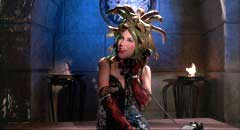 “Monsters
On Demand” (34:19) contains some overlapping information from the commentary
track, but it all comes from some very welcome talking heads. In addition to
Nicolau, Franklin, and Gries, the featurette also includes anecdotes and factoids
from actors Mary Woronov, Chad Allen, and Ian Patrick Williams, as well as producer
Charles Band, composer Richard Band, and effects artists John Carl Buechler
and Cleve Hall. Band reveals that most of his ideas start out as titles and
poster designs, and the artwork that ended up being TERRORVISION’s final
poster was what he showed Nicolau when the then-editor (who began with Band
on David Schmoeller’s TOURIST TRAP) wanted to direct a film (Band also
discusses trying to strike a happy medium between Nicolau’s ideas and
the set budget). Nicolau points out his choice to characterize the family by
some of the worst 1980s stereotypes (swingers, New Wave rockers, and survivalists)
as well as some alternate casting choices like Harry Shearer (THE SIMPSONS)
for the father and Belinda Carlisle as the daughter. Woronov goes into detail
about her conception of her character, as well as her and Graham’s attempts
to out-camp each other onscreen. Allen recalls less about the finished film
than the opportunity as a kid to do things that other kids didn’t get
to do (shooting and blowing things up). Nicolau reveals that he purposefully
did not approach Empire’s regular composer Richard Band because he wanted
something less traditional (he approach The Cramps and Frank Zappa but both
had scheduling problems with Band’s already set release date), and also
discusses why he chose The Fibonacis to compose the film’s songs (he’s
less satisfied with Richard Band’s compositions which he felt tried to
force the humor rather than support it). Nicolau also recalls problems with
effects artist Buechler over the asymmetrical creature design – Buechler
had just wrapped shooting TROLL as director and was working on TERRORVISION’s
effects by day and editing his film by night – but both are satisfied
with the finished project. A poster and stills gallery is included; however,
Scream Factory seems not to have been able to find a theatrical trailer (although
one certainly exists).
“Monsters
On Demand” (34:19) contains some overlapping information from the commentary
track, but it all comes from some very welcome talking heads. In addition to
Nicolau, Franklin, and Gries, the featurette also includes anecdotes and factoids
from actors Mary Woronov, Chad Allen, and Ian Patrick Williams, as well as producer
Charles Band, composer Richard Band, and effects artists John Carl Buechler
and Cleve Hall. Band reveals that most of his ideas start out as titles and
poster designs, and the artwork that ended up being TERRORVISION’s final
poster was what he showed Nicolau when the then-editor (who began with Band
on David Schmoeller’s TOURIST TRAP) wanted to direct a film (Band also
discusses trying to strike a happy medium between Nicolau’s ideas and
the set budget). Nicolau points out his choice to characterize the family by
some of the worst 1980s stereotypes (swingers, New Wave rockers, and survivalists)
as well as some alternate casting choices like Harry Shearer (THE SIMPSONS)
for the father and Belinda Carlisle as the daughter. Woronov goes into detail
about her conception of her character, as well as her and Graham’s attempts
to out-camp each other onscreen. Allen recalls less about the finished film
than the opportunity as a kid to do things that other kids didn’t get
to do (shooting and blowing things up). Nicolau reveals that he purposefully
did not approach Empire’s regular composer Richard Band because he wanted
something less traditional (he approach The Cramps and Frank Zappa but both
had scheduling problems with Band’s already set release date), and also
discusses why he chose The Fibonacis to compose the film’s songs (he’s
less satisfied with Richard Band’s compositions which he felt tried to
force the humor rather than support it). Nicolau also recalls problems with
effects artist Buechler over the asymmetrical creature design – Buechler
had just wrapped shooting TROLL as director and was working on TERRORVISION’s
effects by day and editing his film by night – but both are satisfied
with the finished project. A poster and stills gallery is included; however,
Scream Factory seems not to have been able to find a theatrical trailer (although
one certainly exists).

THE VIDEO DEAD emanate from a used black and white TV set – which only seems capable of showing the B-movie “Zombie Blood Nightmare” – mistakenly delivered to the Shady Lane residence of writer Henry Jordan (Michael St. Michaels) who is discovered dead the next morning. “Three Months Later” Jordan’s house is purchased by the out-of-the-country parents of grown-up Zoe (Roxanna Augesen) and Jeff (Rocky Duvall). Although kooky Texan Joshua Daniels (Sam David McClelland) shows up on their doorstep warning Jeff about the television set, Jeff decides to move it into his bedroom when he finds it in the attic. Strange things start to happen, starting with the death from fright of a poodle being walked by lovely neighbor April (Vickie Bastel, THE DEAD POOL) and Jeff’s creepy encounter with a femme fatale (Jennifer Miro, DR. CALIGARI) who pops out of the screen to seduce him. Another figure out of the TV, “the garbage man” (Cliff Watts), dispatches her and advises Jeff on what to do with the cursed set; but it may be too late since zombies are shambling out of the woods and back into suburbia.
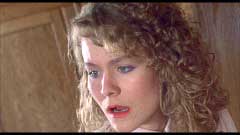 Well-shot
but awkwardly acted and (occasionally) directed, THE VIDEO DEAD is juvenile
– even in terms of its R-rated nudity and gore – but entertaining
with underdeveloped yet likable characters (whose comic delivery is more miss
than hit), and a novel take on the zombies that makes some of their comic antics
somewhat endearing rather than lamely funny (the only lingering question left
with the viewer is what have the zombies been doing shambling around the woods
for three months without anyone noticing). It’s never outrageous enough
to put itself up there with films THE EVIL DEAD or DEAD ALIVE; it’s more
like THE DEADLY SPAWN with less ambition and even less do-it-yourself effects
know-how (rather than a showcase for self-taught effects artists, THE VIDEO
DEAD had already started production before director Robert Scott hired part-time
carpenter/Savini enthusiast Dale Hall to create six distinct zombies for which
he had developed intricate back stories which are not explicitly revealed but
can be picked up from their costumes and behaviors). The film’s budget,
locations, acting and effects scream (affectionately) “regional horror”
– the film was shot in San Francisco and Marin County, but the filmmakers
seem to have made the effort to – but Greg Becker’s cinematography
which is fairly slick and atmospheric (and it probably might have been more
so if Scott had not been trying to ape the look of TV commercials of the era
for his horrific twist on suburbia theme). Future effects artist/director Anthony
C. Ferrante (WISHMASTER 2) appears as one of the zombie extras (well actually,
he’s the hand that reaches out of the TV to attack Jeff).
Well-shot
but awkwardly acted and (occasionally) directed, THE VIDEO DEAD is juvenile
– even in terms of its R-rated nudity and gore – but entertaining
with underdeveloped yet likable characters (whose comic delivery is more miss
than hit), and a novel take on the zombies that makes some of their comic antics
somewhat endearing rather than lamely funny (the only lingering question left
with the viewer is what have the zombies been doing shambling around the woods
for three months without anyone noticing). It’s never outrageous enough
to put itself up there with films THE EVIL DEAD or DEAD ALIVE; it’s more
like THE DEADLY SPAWN with less ambition and even less do-it-yourself effects
know-how (rather than a showcase for self-taught effects artists, THE VIDEO
DEAD had already started production before director Robert Scott hired part-time
carpenter/Savini enthusiast Dale Hall to create six distinct zombies for which
he had developed intricate back stories which are not explicitly revealed but
can be picked up from their costumes and behaviors). The film’s budget,
locations, acting and effects scream (affectionately) “regional horror”
– the film was shot in San Francisco and Marin County, but the filmmakers
seem to have made the effort to – but Greg Becker’s cinematography
which is fairly slick and atmospheric (and it probably might have been more
so if Scott had not been trying to ape the look of TV commercials of the era
for his horrific twist on suburbia theme). Future effects artist/director Anthony
C. Ferrante (WISHMASTER 2) appears as one of the zombie extras (well actually,
he’s the hand that reaches out of the TV to attack Jeff).

THE VIDEO DEAD was released on tape by Embassy Home Entertainment, which was how MGM ended up with the title (along with stuff like THE HOWLING, THE FOG and ESCAPE FROM NEW YORK) by way of acquiring Nelson Entertainment. My memories of the Nelson VHS tape are fuzzy but I recall it looking more like something shot on video, looking more gauzy and untinted during one nightmare sequence; however, MGM’s 1.85:1 HD master – as represented on Shout’s Region 1 dual-layer DVD and Region A BD50 – is probably the best the film has ever looked. The DVD compression actually does the film a favor while the Blu-ray seems more faithfully representative of the low budget 16mm film’s origins; although bear in mind that this is a late 1980s 16mm feature with sharper, finer-grained film stock). The Dolby Digital 2.0 and DTS-MA 2.0 tracks of the original stereo mix are forceful enough in terms of the music stings (with the exception of some chainsaw revving, the mix is otherwise pretty subdued), but the dialogue sounds clearer on the 5.1 Dolby and DTS-MA tracks (even though they are just upmixes of the combined 2.0 source). The optional English subtitles are a welcome touch.
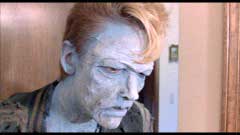 Shout
has gone above and beyond supplementing THE VIDEO DEAD starting with two audio
commentary tracks. The first track features writer/producer/director Robert
Scott, editor Bob Sarles, and effects artist Dale Hall Jr. When asked about
his influences, Scott mentions John Carpenter, as well as THE EVIL DEAD (he
neglects to mention VIDEODROME, and PHANTASM could also have influenced the
bit with the severed hand). Scott also points out that the film’s few
optical effects were created by Wes Takahaski, who was already an animator at
Industrial Lights and Magic. When discussing the influence of Carpenter’s
HALLOWEEN on the score, Scott reveals that he cut together a trailer scored
with the music from that film to attract Sarles to edit the film and to drum
up finishing funds (which he did from eventual distributor Manson International).
Scott and Sarles discuss the cutting of the film, including some judicious “less
is more” pruning of explanations about the video dimension (particularly
in regards to Miro’s femme fatale). Sarles mentions that a cue heard during
the basement scene is a needle drop from the sound studio’s library (the
moderator reveals that the cue was also used in SLUGS).
Shout
has gone above and beyond supplementing THE VIDEO DEAD starting with two audio
commentary tracks. The first track features writer/producer/director Robert
Scott, editor Bob Sarles, and effects artist Dale Hall Jr. When asked about
his influences, Scott mentions John Carpenter, as well as THE EVIL DEAD (he
neglects to mention VIDEODROME, and PHANTASM could also have influenced the
bit with the severed hand). Scott also points out that the film’s few
optical effects were created by Wes Takahaski, who was already an animator at
Industrial Lights and Magic. When discussing the influence of Carpenter’s
HALLOWEEN on the score, Scott reveals that he cut together a trailer scored
with the music from that film to attract Sarles to edit the film and to drum
up finishing funds (which he did from eventual distributor Manson International).
Scott and Sarles discuss the cutting of the film, including some judicious “less
is more” pruning of explanations about the video dimension (particularly
in regards to Miro’s femme fatale). Sarles mentions that a cue heard during
the basement scene is a needle drop from the sound studio’s library (the
moderator reveals that the cue was also used in SLUGS).
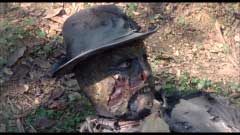
The second track features actors Augesen and Duvall (who was sixteen at the time of shooting) as well as production manager Jacques Thelemaque and make-up effects assistant Patrick Denver (Dale Hall is not credited on the cover or menus but he also appears on this track) is less informative – although they do mention that the film was originally titled CREEPERS, and reveal the back story of one of the zombies (Patrick Treadway, THE WARD) which may have been Scott’s idea or concocted by the actor – but overall a very pleasant listen. None of the participants think that it’s a good movie, but they enjoyed making it and recall their excitement discovering it on the video store shelves. The actors poke fun at themselves without deriding the film. All of the participants hold Scott in high regard for his extreme dedication to the project (the director surprised them all with substantial checks a year or so after shooting wrapped once he had managed to sell the film). There is some discussion of how the effects were created, but Hall and Denver go into more detail in the featurette “Pre-RecorDEAD” (11:47) which also features some snippets of outtake footage (including some mishaps involving bladder effects). Hall mentions the influence of Tom Savini on his work while Denver recalls how the inexperienced effects techs and actors alike discovered the pitfalls of working with dry ice and real chainsaws (they swapped out the chain with a car fan belt and point out where it can be seen in the finished film). Hall also describes applying effects make-up to Miro for her throat-slitting (and blushes very noticeably on camera). Behind the scenes photos are featured in a separate gallery from the film’s posters and promotional stills, and the film’s theatrical trailer (1:39) is also included. Seemingly a Blu-ray exclusive is a brief selection of silent outtakes (1:51) – scored with the film’s main theme music – since the featurette is not on the DVD version. The film’s 93-page first draft screenplay is available as a DVD-ROM supplement in the PDF format (it’s too bad Scott – who works now regularly as a first assistant director on TV shows like HOUSE M.D. and HEROES – didn’t write more as this one isn’t a bad read). (Eric Cotenas)